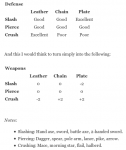I am enjoying this back-and-forth very much. (Particularly because I'm not in the thick of it for once).
It is teaching me things because I am squarely in the OD&D camp but am looking for ways to improve that elegantly simple game with elements proven to work well for others. I most definitely want to hear about others' play experience. Nothing is more valuable that real-world data.
The case for some of the AD&D (1e) improvements over OD&D seems strong (and easy to add). One might argue that the 1e DMG is an open letter by Gygax to OD&D DM's trying to help them out of some jams.
Even circling back to the original topic of the thread---I also want to hear what's good about 5e. For example, advantage/disadvantage sounds like a nice nuance over DM fiat (i.e. I'll give you XX% change of that working). Something to experiment with, and that wouldn't break the basic game.
EOTB has stated he already has everything he needs in 1e (and owns a Jeep).
I do not. (...err...for D&D, or a Jeep...)
I am looking to cherry-pick and find my personal (best) groove, and I am not done shopping. (...err, for D&D...or Christmas...)
Please, continue.
here are some free systems that I have enjoyed perusing the rules of. this one is three bucks. I've not looked at this one, but everyone likes it. The last two have examples of advantage is an old-school style system. There are cheap DCC starter rules from 'Free RPG DAY' that you can find on DrivethruRPG, but the rules from the actual full rulebook are written much better. A good chunk of what makes DCC so fun is left out of the starter rules, so I am not going to link that one.
Also, here is the funniest and best designed class I have seen on a blog. Gothic Villain


